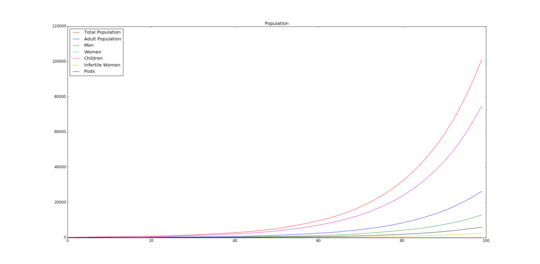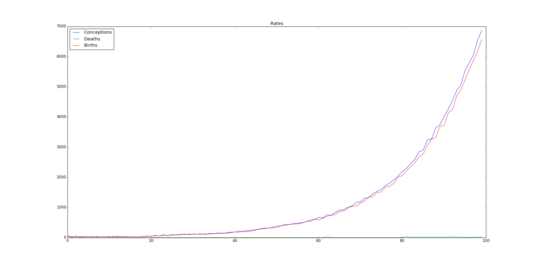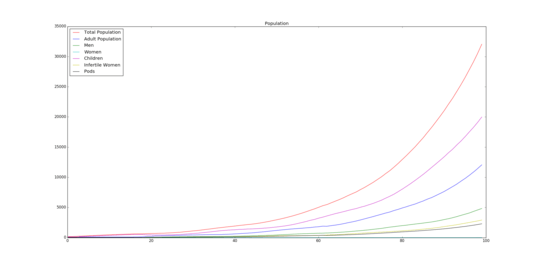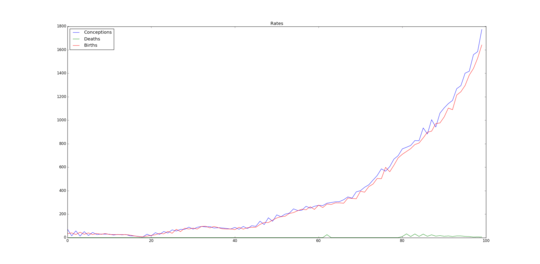0
So, my friend had an idea for a weird Post Apocalypse society traveling through space towards Proxima Centauri B, and she's trying to figure out where the population would be 50 and 100 years after the start. I tried to work out the math and got lost four times.
First, let's assume that for whatever reason, humans have been reduced to just 100 individuals as distantly related as possible. There is no larger group to join at the end of the journey.
Second, this groups consists of 25 males and 75 females. The synthetic intelligence has determined that dividing them up into family pods of 1 male and 3 females is the best setup to ensure both survival and genetic diversity. (Just to be clear, no, I don't know why she chose this arrangement, but I suspect it's to generate controversy.)
Third, the SI determines that every individual should have a child every 20 months, or 1.6 years, after reaching the age of 18 to ensure the greatest chance of a child being born. (See my comment above.)
Assuming that their are no deaths caused by accidents, catastrophes, etc., and an absolute lifespan of 80 years, and with the standard division of gender in offspring what would the population total look like in 50 and 100 years? Also, how many family pods would there be and what would the gender division of individuals that don't fit into the 1m:3f family pods look like at those year points?
Edit: Solved! Pretty much, anyway. Thanks to JBH and bendl for all their effort on this. Oh, and thanks to FreeElk for a good laugh. All three of you have been voted up.




7What's a PA colony? Parents' Association? Professional Association? Party Affiliation? Placement Agency? Now to be helpful with your simulation: males and family arrangements don't count; all you have to do is simulate the females, and multiply by 1.33 at the end. (1.33 because you said there are 3 women for every man.) Note that in order to sustain the hareems of 3 women per man the "synthetic intelligence" (don't you also need an "analytic intelligence"?) must either abort 2 male fetuses out of 3 or else use artificial insemination, because otherwise the sex ratio at birth is about 1:1. – AlexP – 2017-12-28T01:32:32.503
1I think PA stands for Post Apocalypse, but let's let the OP clarify first. – Vylix – 2017-12-28T02:21:30.947
Yes, PA stands for Post Apocalypse. I apologize for not being more clear in that. Also, I'm asking for help here because there are no "premature" deaths. All individuals live to 80. That's part of why I asked about the gender division and the pods. My friend expected there to be "floaters" who don't belong to a pod. I'm not sure what she's planning to do with them. – Master Zoen – 2017-12-28T03:58:07.643
@AlexP Yes, I think she's talking about a Party Affiliation society :D – NL628 – 2017-12-28T03:58:10.847
I, and I'm certain my friend, wasn't aware that artificial insemination could be used to control gender of a fetus. Is that really possible? – Master Zoen – 2017-12-28T04:10:42.177
I don't see how a post-apocalyptic group of 100 would have the resources available to create, launch, and maintain an interstellar ship. I also don't see how this math problem isn't easily solvable with a simple spreadsheet. – user535733 – 2017-12-28T04:26:52.950
It is highly unlikely that a mere 100 people can create a sustainable colony. See my answer to this other question for a detailed answer as to why. Any self-sustaining colony has no problem with genetic diversity and the prediction of its size becomes fairly simple.
– JBH – 2017-12-28T05:06:37.917@user535733, I never said that the 100 individuals did those things, only that they were all that's left and were traveling to Proxima Centauri B. Also, I don't know anything about spreadsheets. – Master Zoen – 2017-12-28T05:15:29.387
@AlexP, perhaps I'm misunderstanding something, but you mean to say that I take the original value of 75 females and multiply by 1.33, then multiply again by the number of years? By my math that comes out to just shy of 5,000 people at the end of 50 years and just shy of 10,000 at the end of 100 years. Does that seem right? – Master Zoen – 2017-12-28T05:22:37.350
@JBH, I never said that they could create a sustainable colony. I said they were all that is left and I'm only interested in what their population numbers would be a certain number of years later. – Master Zoen – 2017-12-28T05:27:59.730
You didn't read the issues clearly. You can drop 15 people anywhere and, if they're clever enough, they can create a stone-age society that will perpetuate themselves (assuming enough genetic diversity). But if you want to maintain any level of technology at all (requiring metalurgy) then you're stuck with thousands as the minimum number. You appear to be looking for an unrealistic ideal since it requires supporting the technology that allows a synthetic intelligence.... – JBH – 2017-12-28T05:31:42.163
Controlling sex ratio by artificial insemination: sperm sorting by sex is a thing. It is practiced routinely in, for example, cattle.
– AlexP – 2017-12-28T11:52:10.8704Uh huh, "Asking for a friend" about 3:1 ratio of women to men. I've heard that line quite a few places but never expected to hear it on world building ^^; but in all seriousness we don't care, it is a lot easier to talk directly to the writer though, whether that is you or your friend. – FreeElk – 2017-12-29T00:08:11.213
LOL That's cute, but any more than one woman regularly would leave me too tired to do anything. I'm not a writer, and nor is she. She's trying to create a Sci-Fi RPG setting for an upcoming game campaign that is sort of grim dark. There is no happy end for these people. She just wants to know where the pop. will be at certain points, which I think AlexP has already helped us figure out. I appreciate the laugh, FreeElk. – Master Zoen – 2017-12-29T05:08:35.607
@AlexP, that's so weird. I'm not sure I really wanted that confirmed, seems scary. – Master Zoen – 2017-12-29T05:11:37.707
Thanks go out to bendl and JBH for all their efforts on this. – Master Zoen – 2017-12-29T14:56:20.860
2your family pods will disappear after the first generation, since the gender division will even out, there may even be too many males after the first generation, since there is some evidence of a response in birth to existing sex inequality. – John – 2017-12-29T15:18:32.263